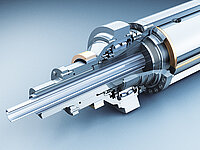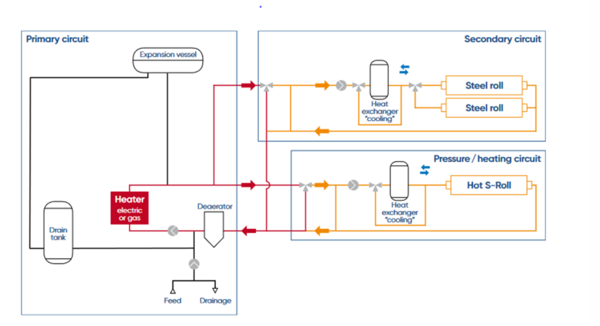
Nonwovens for medical masks and diapers, paper for a wide range of products and textiles of all kinds – they all have one thing in common: In their production, calenders are needed, in which an invention from 1956 is usually used. Back then, Eduard Küsters revolutionised calender and roller technology with a floating roller, the S-Roll. The rotating roller shell of a bending compensation roller is hydrostatically supported on a fixed axle, so that the same linear force acts on the material over the entire width. Previously, the calendered materials had different strengths, but thanks to Eduard Küsters’ S-Roll, this problem soon became a thing of the past.
Today, ANDRITZ Küsters is part of the ANDRITZ Group, a leading international technology group. ANDRITZ Küsters has been successfully supplying turnkey production systems and machines, engineering, project management and service for the paper, nonwovens and textile industries for more than 65 years. The company offers tailor-made technical solutions and services for a variety of applications – from highly complex processes to standard solutions for growth markets.
The term calender comes from the French word “calandre” for roller. In mechanical engineering, this refers to a system consisting of several rollers arranged one on top of the other. The material to be processed passes through the gaps between the pressurised rolls, similar to a laundry mangle. In order to compensate for the natural deflection of the rollers, a steel axle filled with oil is located inside the bending compensation roller, the S-roll. This stationary steel axle, which functions as a support, is sealed against the rotating outer roller in such a way that hydrostatic pressure can be built up with the oil. The elastic outer roller shell can then be deformed by the pressure differences in the oil in such a way that a uniform linear force can be generated on the material to be calendered.
In the nonwovens industry, in addition to the uniform linear force, the rollers also need to be heated. The individual fibres of these nonwovens are also thermally bonded together and solidified. Lightweight nonwovens such as medical masks and hygiene products can only be manufactured in this way. The ANDRITZ Küsters Hot S-Roll is used in their production. It works with a surface temperature of up to 275°C.
For this purpose, the rollers installed in the calender are indirectly heated to this temperature with heat transfer oils. In a heating system operated with gas or electricity, two different heat transfer oils are usually heated, which supply two separate oil circuits. A mineral-based heat transfer oil with a viscosity of up to 490 mm²/s at 40°C is used for the Hot S-Roll. The heat transfer oil in the primary circuit is heated to almost 300°C. Separate secondary circuits supply the calendar rollers. The heating pressure circuit supplies the Hot S-Roll. The heat transfer oil in the Hot S-Roll has the following functions: Heating, lubrication and pressurisation.

Only mineral heat transfer oils approved by ANDRITZ Küsters should be used as heat transfer oil for the primary circuit of the Hot S-Roll. Sustainably trouble-free operation of the system depends on these oils, which must also supply the sealing strips and mechanical seals installed in the S-Roll.
In principle, a heat transfer oil should have the following properties:

Up to 3,000 litres of mineral heat transfer oil are required in the primary circuit that supplies an ANDRITZ Küsters Hot S-Roll. In order to achieve service lives of up to seven years, the oils are continuously maintained and regularly monitored with oil analyses. After all, even a high-quality heat transfer oil at temperatures of almost 300°C is not immune to thermal decomposition.
ANDRITZ Küsters uses OELCHECK all-inclusive analysis kits 3 to check the heat transfer oils of the S-Rolls and Hot S-Rolls and also recommends these to all system operators. OELCHECK’s all-inclusive analysis kits for heat transfer oils meet the requirements of DIN. Finally, in Germany and in many other countries, an annual inspection of the heat transfer oils in accordance with DIN 4754–1 is mandatory.
In addition to the flash point and general oxidation state, this includes the water content, impurities, possible mixing such as with an oil from the other circuit, a change in viscosity as well as existing wear particles.
For large industrial systems, OELCHECK also recommends determining the coke-forming tendency according to Conradson in accordance with DIN 51551 (CCR, Conradson Carbon Residue). Especially in large systems, coke-like deposits can form on seals, on components such as mechanical seals or in the piping of heat exchangers. These residues cause the oils to age faster and become acidic. In addition, they become more flammable because the deposits cause the viscosity and flash point to drop.
By determining the coking tendency according to Conradson in accordance with DIN 51551 (CCR, Conradson Carbon Residue), OELCHECK also determines whether a used heat transfer oil tends to form harmful deposits. If the limit or warning values defined by OELCHECK tribologists with the system or oil manufacturer are exceeded, OELCHECK tribologists advise changing the oil or rechecking the system after a shorter period of time, depending on the operating time and system size. – For good reason, OELCHECK recommends checking the coke value of all large-volume systems whose heat transfer oils are exposed to particularly high temperature loads, as integrated in the all-inclusive analysis kit 5.
Part of a leading international technology group
ANDRITZ Küsters, headquartered in Krefeld, Germany, with a branch in Spartanburg, USA, supplies technologies and services for the paper, nonwovens and textile industries. The company is a globally recognised specialist for paper, nonwoven and textile calenders, wetlaid nonwovens, coating and finishing systems. The Krefeld site also houses a modern roller service centre, where rollers are prepared, repaired or modernised for international customers.
ANDRITZ Küsters is part of the international technology group ANDRITZ and employs around 350 people. The ANDRITZ Group is one of the world’s leading suppliers of innovative plants, equipment, systems and services for the pulp and paper industry, hydro-power, the metal processing industry and forming technology, pumps, municipal and industrial solid-liquid separation as well as animal feed and biomass pelleting. The listed technology group from Austria employs around 27,200 people at over 280 locations in more than 40 countries.
OELCHECKER Spring 2022, page 3,4
For further information see: www.andritz.com
